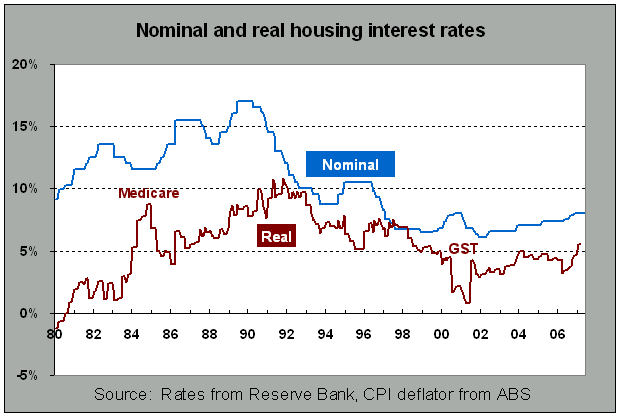The housing
story: the reality of interest rates
“Wotcher gonna do ‘bout ‘ousin?” a lady screamed at Bob Menzies in a 1960s town hall election rally. “I’d put an ‘h’ in front of it” was his prompt reply. In such situations a quick wit is a good substitute for considered policy. Forty years on, we are still groping for practical solutions to housing affordability.
There are many factors driving the price of housing and therefore housing stress, including land servicing costs (which are now borne by the purchaser rather than the wider community), distortions in the taxation system which encourage housing speculation, immigration, geographic limits on urban expansion and demand fed by government grants and inheritances. In this article, however, I want to focus on one rarely-considered factor contributing to housing stress – the effect of behavioural changes in response to mortgage interest rates. Australians place a high value on housing. While we may, say, choose a $20,000 car rather than a $30,000 car, in housing we tend to go for what we can afford, using a decision rule such as what we can afford if mortgage servicing takes up 25 percent of our income. There is no question that the high mortgage interest rates of the late 1980s limited housing affordability. In 1989, Peter Costello likes reminding us, variable mortgage rates peaked at 17.0 percent. Let’s see what effect that high rate had on a couple, each earning the average adult wage at the time ($26,611), taking out a mortgage over 20 years. If they devoted 25 percent of their combined income to their mortgage they could afford to commit $13,306 a year, which would service a mortgage of $74,880 in 1989 prices, or around $129,000 in 2007 prices. If the same couple were buying a house now, their mortgage interest rate would be only 8.05 percent, and the adult wage is now $55,920. Applying the same “25 percent of income” decision-rule, they could afford to spend $27,960 a year on their mortgage, which can service a mortgage of $273,000. In real terms, that’s more than twice the value of what they could have afforded in 1989. While some effect is due to higher real wages (which have risen by about 20 percent over that period), most is due to lower interest rates. So far, this analysis confirms the conventional wisdom: lower interest rates result in greater housing affordability. Let’s look at that “25 percent of income” rule, however. It is based on our capacity to make immediate repayments. But a mortgage stretches out over many years, and, if we were truly rational beings, blessed with perfect foresight, we would weigh up our capacity for repayment over the period of the mortgage, taking into account our expected earnings over that period. The 1980s were a time of high inflation, which was feeding into prices and wages. Interest rates (what economists call “nominal” interest rates because these are the rates “nominated” in loan documents and everyday language) may have been high, but so too was inflation. The mortgage may have imposed an immediate 25 percent burden, but if wages were rising at 8 percent a year, while the mortgage stayed constant, that burden would fall to 23 percent after a year, 21 percent after two years, 20 percent after three years, and so on. (In fact, those who took variable-rate mortgages in the late 1980s peak soon found not only their incomes rising but also the interest rates falling.) The burden of mortgage repayment was heavy initially, but it soon lightened. We have many means of coping with temporary stress, such as deferring replacement of cars, furnishing and appliances, deferring having children and extending credit card debt. Coming forward to the present time, inflation is low, and people cannot expect such automatic relief. Even if their employment is reasonably secure, they cannot expect their income to rise much higher than inflation, which is now running at only 2.4 percent a year. The burden of high mortgage repayments will hang around much longer than for their predecessors, thirty years earlier. The struggle lasts longer, and, for many, the prospect of falling back to one income is unthinkable.
Economists will recognize that what is being referred to in this article is the effect of real, as opposed to nominal interest rates. Nominal rates are those we see everyday, in the advertisements of banks and other lenders. Real rates take into account inflation. The relationship is mathematically simple:
So, in 1989, when nominal rates were seventeen percent and inflation was eight percent, real rates were around nine percent. Now, with nominal mortgage rates around eight percent, and inflation at around two percent, the real rate is more like six percent. There has been a fall, but not of the magnitude we hear in the political debates, and, unlike 1989, there is now no prospect of an immediate fall in rates. (By 1991 rates had fallen by four percent; as inflation fell, nominal interest rates also fell.) For political reasons Peter Costello and others in the Government don’t talk about real rates, which have moved in a band of about two to ten percent over the last thirty years – not a very exciting political story. And Labor seems to be reluctant to go forth with any messages with the slightest suggestion of economic complexity.
Certainly no-one would advocate a return to high inflation as a way of easing the burden of mortgage re-payments, even though it would be effective in the short run. Rather, we need some way to moderate those decision rules based on immediate repayment – which are being stretched beyond 25 percent to even more onerous figures such as 30 percent. Certainly, it would be useful to cover the concepts of real and nominal interest rates in school and financial literacy programs, but there are many parties, besides politicians, who want to keep us thinking in nominal terms. Employers wouldn’t want to see their offers of wage rises discounted to real terms, and neither would union officials, who want to be able to boast about the rises they negotiate for their members.2 Research in behavioural economics shows that education, in itself, only partially improves decision-making. Behavioural economists find that we are very myopic in our decisions to borrow. We tend not to think of the future burden of repayments. In the 1980s such myopia didn’t matter much; it was compensated for, as rising nominal wages eroded the burden of a nominally fixed mortgage. That compensation is now very much attenuated, and the mortgage burden we bear this year will be with us for many years to come. Patterns of consumer behaviour are hard to change, particularly when people are surrounded by the din of financial institutions and ‘innovative’ lenders selling mortgages, and when politicians are boasting about low interest rates. The reality is that Australia’s interest rates are now on a steep upward trajectory, and are close to the highest among all developed countries. It may be more fruitful to search for solutions on the supply side. Some have suggested fiscal reform, such as abolishing ‘negative gearing’, reverting to the previous neutral capital gains tax regime, extending the jurisdiction of the Australian Prudential Regulatory Authority to cover non-bank lenders, and abolishing the double counting of interest and depreciation in housing investment. Another possible area of reform is prohibition of the practice of commission-based selling, whereby the employees or agents of financial institutions are paid on a percentage of the loans they sell. This practice, said Louise Sylvan when she was CEO of the Australian Consumers’ Association, is a form of structural corruption”, resulting in over-commitment by borrowers, housing price inflation, and, as we are starting to see, concerns about the stability of our financial markets. Notes 1. The actual formula is a little more complex. The real rate is (1+nominal rate)/(1+inflation) – 1, but that approximates to the simplified form nominal – inflation. In 1989 the nominal rate was 17.0 percent and inflation was 8.0 percent, giving a more precise real rate of 8.3 percent. Keynes’ solution to the stagnation of the Great Depression was to give a large nominal wage rise, which was actually a cut in real terms. Seventy years later people have learned how to adjust wages for inflation, but they have not applied the same learning to interest rates. .
|


